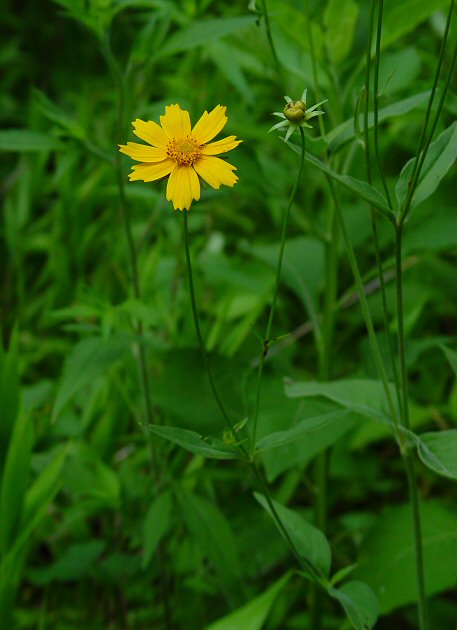Coreopsis pubescens Elliott
Star Tickseed

Native
CC = 7
CW = 3
MOC = 42
© DETenaglia
Coreopsis pubescens ElliottStar Tickseed | |
 |
Native CC = 7 CW = 3 MOC = 42 |
© DETenaglia |
|
Family - Asteraceae/Heliantheae Habit - Perennial forb, with a short, sometimes branched rootstock. Stems - Ascending to erect, to 1 m, often branched in apical 1/2, pubescent with spreading multicellular hairs.
Leaves - Opposite, short-petiolate, distributed at 6-12 nodes along most of the stems. Blades 1-8 cm long, elliptic to ovate in outline or those of the uppermost sometimes narrower, unlobed or with 1 or 2 deep basal lobes or divisions (rarely fully compound), in entire leaves the blade angled or tapered at the base, in divided leaves, the lateral lobes or divisions much shorter than the terminal lobe or division, 4-12 mm wide, lanceolate to ovate or elliptic, rounded or angled at the base, angled or tapered to a usually sharply pointed tip, the upper surface glabrous or with sparse, minute hairs along the midvein, the undersurface moderately pubescent with short, spreading hairs, the sometimes narrowly whitened margins relatively densely pubescent with minute, loosely appressed hairs. Petioles to 1.5 cm long, hairy, minutely winged.
Inflorescence - Usually single flower heads terminating long peduncles. Peduncles to 15 cm long, pubescent near base, glabrous near apex. Heads - Radiate, showy. Involucre cup-shaped, the bracts dimorphic. Bracts with the outer series 3-7 mm long, green, glabrous, the inner series 9-12 mm long, yellowish, glabrous. Chaffy bracts narrowly triangular, long-tapered from an abruptly broadened, flat basal portion to a sharply pointed tip. Receptacle convex.
Ray flowers - Typically 8 per flower head, sterile, the corollas 12-25 mm long, with 3-5 deep, sometimes irregular, jagged teeth or lobes around the tip, uniformly yellow. Disk flowers - Perfect, the corollas 3.5-4.5 mm long, 5-lobed, yellow, sometimes with yellowish orange lobes. Style branches tapered abruptly to a sharply pointed, sterile tip. Pappus of 1 or 2 scalelike teeth 0.1-0.4 mm long.
Fruits - Achenes 2.5-3.5 mm long, the base and tip appearing curled or arched inward at maturity, the angles with broad, pale wings having entire or more commonly somewhat irregular margins, the inner face with a bulbous thickening at 1 or both ends, dark brown to black, 1 or both surfaces with numerous small, lighter-colored tubercles. Flowering - May - September. Habitat - Forests, bluffs, streambanks, roadsides, railroads. Origin - Native to U.S. Lookalikes - Other species of Coreopsis; more broadly, some species of Bidens, Helianthus, etc. Other info. - This pretty, native species of Coreopsis is found in the southern half of Missouri, which is its region of greatest abundance. Beyond Missouri it ranges into several southeastern states. It is reasonably easy to recognize by its showy all-yellow flower heads, opposite oval leaves, and hairy stems. The plant does well in cultivation and grows well from seed. Photographs taken at Alley Spring, Shannon County, MO., 6-16-03 and 6-12-04 (DETenaglia); also near Noblett Lake, Douglas County, MO, 6-2-2017, and at Millstream Gardens Conservation Area, Madison County, MO, 7-4-2017 (SRTurner). |